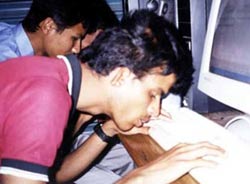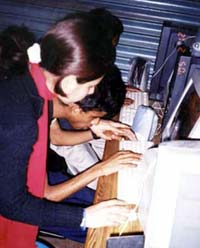Blind and Visually Impaired Youth Introduced to ICT at Nepal CMC
15-06-2005 (New Delhi)

© UNESCO
Lumbini Community Multimedia Centre (CMC) has recently organized a one-day orientation programme for blind and visually-impaired students of Shri Shanti Model Secondary School in Manigram, a village in Western Nepal. Shri Shanti local government school has about 850 students twenty-eight of which are either blind or visually impaired.
“For me, the computer was entirely new. I had never used it before. The centre here not only gave me an opportunity to know about ICT, but also arranged training for me and other students,” said an excited Kamal Tharu. Kamal is a visually impaired student in class nine of Shri Shanti School, who has participated, together with seven other students, in the ICT orientation organized by Lumbini CMC.
The inspiration for the training was a visit to the CMC by two visually impaired students. Sagar Subedi, one of them, had taken part in a training workshop on a text-to-speech software called JAWS. When he heard that the Lumbini CMC had also obtained the software, he and a friend came to investigate. The JAWS software literally reads text from computer documents, including Internet websites and e-mails.
“Blind and visually-impaired students attend classes along with other students. They come from as far as Gulmi, Chitwan, Parbath and Agrakashi (all neighboring districts). The recent one-day training by CMC has increased their desire to learn about basic computing and Internet,” reports Krishna KC, Shri Shanti’s resource teacher for disabled and Lumbini’s chief radio technician.
The Lumbini CMC was established in April 2004 as part of Radio Lumbini, a community radio station in the plains area of Western Nepal. Community Multimedia Centres combine new technologies like computers, Internet and specialised software applications with traditional media. In Lumbini’s case, it is a community radio established in 2000, one of the first in Nepal and South Asia.
In the past year, the Lumbini CMC worked with over 200 local users, imparting computing skills, increasing information literacy and providing access to a range of knowledge resources. Users come from a variety of socio-economic backgrounds, allowing the centre to offer services to marginalised groups and generate income from more affluent sectors of the local community.
Making the CMC work for traditionally marginalised and underrepresented groups is a high priority. Specialised programmes to meet their needs are now in development. In May 2005, fifteen speech- and hearing-impaired trainees began a three-month course on basic computing and Internet training. Once appropriate keyboards are in place, the CMC plans to launch a three-month basic computing and Internet training for the blind and visually impaired. Both courses are designed to introduce participants to ICT, provide exposure and open up new possibilities and opportunities.
The inspiration for the training was a visit to the CMC by two visually impaired students. Sagar Subedi, one of them, had taken part in a training workshop on a text-to-speech software called JAWS. When he heard that the Lumbini CMC had also obtained the software, he and a friend came to investigate. The JAWS software literally reads text from computer documents, including Internet websites and e-mails.
“Blind and visually-impaired students attend classes along with other students. They come from as far as Gulmi, Chitwan, Parbath and Agrakashi (all neighboring districts). The recent one-day training by CMC has increased their desire to learn about basic computing and Internet,” reports Krishna KC, Shri Shanti’s resource teacher for disabled and Lumbini’s chief radio technician.
The Lumbini CMC was established in April 2004 as part of Radio Lumbini, a community radio station in the plains area of Western Nepal. Community Multimedia Centres combine new technologies like computers, Internet and specialised software applications with traditional media. In Lumbini’s case, it is a community radio established in 2000, one of the first in Nepal and South Asia.
In the past year, the Lumbini CMC worked with over 200 local users, imparting computing skills, increasing information literacy and providing access to a range of knowledge resources. Users come from a variety of socio-economic backgrounds, allowing the centre to offer services to marginalised groups and generate income from more affluent sectors of the local community.
Making the CMC work for traditionally marginalised and underrepresented groups is a high priority. Specialised programmes to meet their needs are now in development. In May 2005, fifteen speech- and hearing-impaired trainees began a three-month course on basic computing and Internet training. Once appropriate keyboards are in place, the CMC plans to launch a three-month basic computing and Internet training for the blind and visually impaired. Both courses are designed to introduce participants to ICT, provide exposure and open up new possibilities and opportunities.
 © UNESCO
© UNESCORelated themes/countries
· News Archives 2005
· Nepal: News Archive 2005
Share this story:
Contact information
-
Contact
- Ian Pringle, UNESCO New Delhi
- UNESCO New Delhi
Source
- UNESCO New Delhi
Field office














